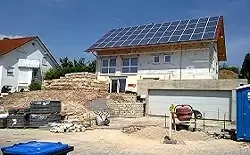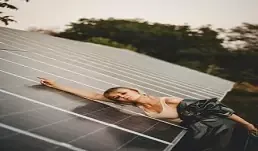Solar panel system for home
Solar panel systems for home are growing in popularity and cost is declining. Many homeowners are
exploring the benefits of solar power and you may have seen many systems
installed in your neighborhood.
If you want
solar and want to know more, it can all feel a little too much. You may be
wondering: How much does it cost to install a solar system, and how much will I
really save on my electricity bill? Let's start with the basics.
In this article, we will give you an overview
of solar energy so that you can have a strong knowledge base and make the best
educated decisions about solar energy for your home.
 |
| Solar panel system for home |
What is a solar panel system?
A solar panel (or photovoltaic panel)
is a panel made of solar cells. Solar cells are essential components that
convert light into electrical energy and are usually made of crystalline
silicon.
Each solar panel typically consists of 32 to 96 solar cells. Depending on the method of
formation of solar cells, solar panels are classified as polycrystalline lines,
monocrystalline line, or thin films.
The first two types, the most common type of solar
panel, are made up of crystal solar cells. The third type (thin film) is
made of non-synthetic silicon. In addition to ordinary framed solar panels,
there are other types of products that can be used in residential applications.
Frameless solar panels have been on the market
for over a decade. Also, the popular solar paints and solar tiles from Tesla
Solar Roof is two types of products that are becoming more popular in
residential applications as they combine the technology of solar panels with
aesthetic integration in the home.
From solar energy, cells generate electricity
by converting the tremendous solar energy that the earth receives every day in
the form of sunlight, and especially in the form of photons.
Most common commercial solar solutions emit
sunlight at an average efficiency of 3 to 17%.
Therefore, photons are practically the
smallest possible energy packages of sunlight. First, the top layer of solar
cells has a reflective coating that helps them collect more light.
At the very bottom, we have the central layer
of the solar cell, which is basically a sandwich of two silicon layers. Both of
these layers are specially treated to retain the excess amount of electrons in
the upper layer while the lower layer lacks electrons.
 |
| Solar panel system for home |
What is needed to move the extra electrons from top to bottom is a little bit of extra energy! And this energy is provided by photons when sunlight hits solar cells! When solar panels are exposed to light, an electric current is generated! The more sunlight hits the solar panel, the more electricity is generated.
This means
that on cloudy, rainy, or snowy days, when the sunlight is low, solar panels
still generate some electricity but it is limited compared to the electricity
generated on a sunny day. Solar panels certainly don't generate electricity at
night, but you can store the extra energy stored during the day in a large
battery.
Solar panels must be placed somewhere so that
sunlight does not hit them directly and is not obstructed by shady sources such
as trees. To have a complete power generating system for your home, you will
need the following components:
 |
| Solar panel system for home |
1Solar panel
2 Solar panel
mounting structures
3 An inverter
4 Essential
switches and circuit breaker electrical panel
5 DC and AC power
cables and Power meter.
Let's take a look at these individual
components. As we mentioned earlier, when solar panels come to light, they
generate electricity. More specifically, they produce a DC electric current. But
in order to use the electricity generated from solar panels, we need to apply
AC electric current (alternating current) which is the type of current used by
your home and power grid.
So, we need an inverter! An inverter converts
DC electricity produced by solar panels into alternating current (AC). Solar
panels are connected to the inverter, not one by one, but in groups called
wires.
Electrical Panels, Wiring, and Electricity
Meters To distribute AC AC electricity to a home or home, it is necessary to
install the necessary switches, circuit breakers, and wired electrical panels,
while the electricity meter is used to install photovoltaics. Measure the power
generated by the system.
Many modern systems have handheld apps on your phone so you can see how much energy you are generating, quite satisfying. In general, residential solar systems are divided into 2 main types: off-grid and on-grid.
In the case of an off-grid system, the power
generated by the solar system will be used to meet 100% of the electricity
consumption because the house is not connected to the power grid (power
company) at all. This can be accomplished using large batteries that will store
any extra electricity generated during the day.
 |
| Solar panel system for home |
The main disadvantage of an off-grid system is
its cost, as using batteries increases the cost by about 30-30% compared to a
grid system. Many jurisdictions do not allow you to run your residence off the
grid, so you need to check.
In a grid, the system, the house in which the solar panels are installed is connected to the
main power grid. The electricity generated from solar panels can either meet
the electricity needs of the household or when you generate too much
electricity, it is sent to the power grid.
This leads us to net metering. Through net
metering, your monthly electricity bill calculates both your total energy
consumption and your monthly output from your solar panel.
The company will actually pay you if you are
producing more energy than using utilities! For example, if your solar panel
produces 3,000 kWh on sunny days and you use 4,000 kWh from the grid on dark
nights, The bill will be charged, in fact, electricity measuring networks
actually, pay a higher rate than you have created from the solar panel system
from which you pay to buy electricity from the grid.
How much you actually save depends on a number
of factors, the most important of which are: How much electricity is used in
your home or business: Of course, how much electricity is used in your home or
business. The average electricity consumption for a home was 10,766 kilowatts -
times, an average of 7,897 kilowatts a month, and a typical home solar
installation aims to make your monthly usage 70-90 off.
Of course, the right savings on your
electricity bills depend on other factors. If your family has electric cars
that need to be charged daily, your electricity needs will be much higher.
Where you live is very important. Summer is
better. For example. A 5 kW installation of 20 solar panels can generate about
8,000 kWh per year if your home is in a hot and sunny state like California,
but the same system can only generate 6,000 kWh per year. If you have a house.
In a less sunny state like Connecticut.
This means that a 5 kW system can cover 60 to
80 percent of your electricity bill, depending on how sunny your area is,
depending on the average annual electricity consumption of 10,000. Kilowatt-hours are consumed. At your address
And it calculates how much electricity you can
generate, and how much you can save on your electricity bill. I have linked to it
in detail. The available surface on your roof, the properly oriented shaded
part determines how many solar panels you can install and as a result, you will
save. A simple thing to keep in mind is that you need about 350 square feet to
install 20 solar panels, with a total power of 5 kW, which is the average solar
power system in the United States.
 |
| Solar panel system for home |
The tool I just mentioned actually allows you
to select your roof on Google Maps and adds an element to the calculation. The
inclination and orientation of your roof are also important.
To generate
as much electricity as possible, the solar panel should face south and your
roof should be tilted, with sunlight hitting vertically on average throughout
the year.
The farther north you go, the more inclined
your roof should be. The average price of a residential solar panel in 2019 is
99 2.99 per watt, so with an average solar panel system size of 5 kW, you're
looking at an average price of $ 14,950 before any tax credit or incentive.
These goods make up the bulk of the cost, but
licenses and wages are also obtained. You can deduct for the existing federal
solar tax credit and there are many other local benefits offered by your state
or your utility company.
These prices, of course, depending on the brand
of the solar panel, the size of your installation, your installer, and your
state, but this is to give you an accurate idea of what to expect. Remember
that the cost of solar energy has been steadily declining over time.
The best way to get a good price on Solar is
to compare references from many different installers, and there are some great
services for this which are attached in detail below.
Based on the parameters we have already mentioned, such as prices, electricity usage, or your business, how sunny your region is that a solar energy provider can help you determine if more What would be the ideal system for you to save more than. On your electricity bills
Don't forget that there are many brands of
solar panels and solar inverters to choose from, and a good installer can help
you choose the most suitable system for your budget.
The most
important parameters that determine whether a roof is suitable for solar panel
installations is its inclination and direction. Your solar provider can
calculate how much sunlight your roof will receive throughout the year.
Although solar panels weigh about 2-4 pounds
per square foot, structural safety is definitely another important factor. For
new homes, the design of the entire mounting structure with solar panels must
have a static view of the roof.
For existing homes, the services of a professional structural engineer are required to inspect the roof structure and
calculate the structural load capacity.
Since there are virtually no moving parts in a
solar installation, minimal maintenance is required. However, to ensure that
routine maintenance is required, the system is performing properly.
Harmful symptoms for solar panels: -
Solar panels require routine inspections for
signs of damage, dirt buildup, or shady encroachments. Although solar panels
are usually designed and installed to clean from rain, they should be cleaned
manually if there is dust or any other opaque material.
From time to time, the growing structure in the system must be checked for corrosion so that the photovoltaic system is safely protected. Also, any solar system connected to the home's electrical grid is a solar power installation, so a licensed electrical engineer should be appointed from time to time to ensure power safety
In short, there are some pros and cons to the
solar system. A renewable energy source reduces your electricity bill and
provides insurance against rising electricity prices. Low maintenance costs.
Financial incentives from the government. They run quietly, without moving
parts, and emit zero pollution. Do
 |
| Solar panel system for home |
They have a long life and reliable service?
The guarantee given by the manufacturers for solar panels is generally more
than 25 years of good operation.
Initial costs, but minor costs come to zero
once the installation cost is paid. Depending on the weather it is, therefore, an
intermittent source of energy, and cannot be relied upon for critical
applications.
Energy storage systems for smooth demand and
load are expensive like Tesla electric wall Are you ready to run on solar energy?
Be sure to share your thoughts on this.
Surface Duo first look
The evolution of computers and technology

Post a Comment